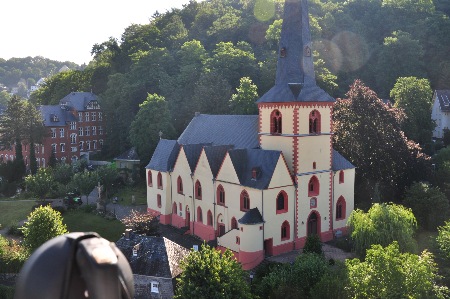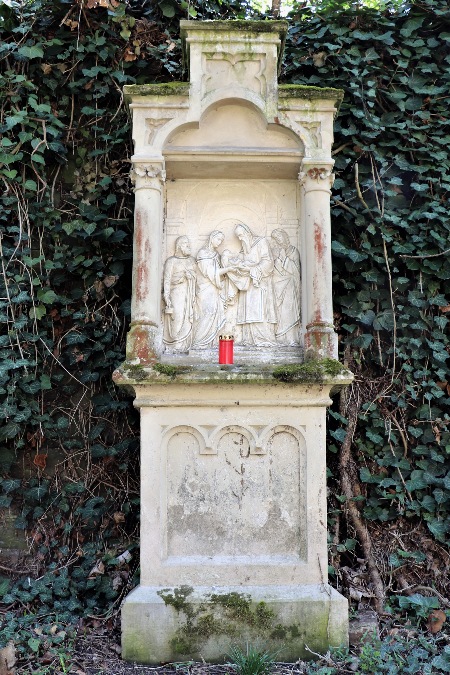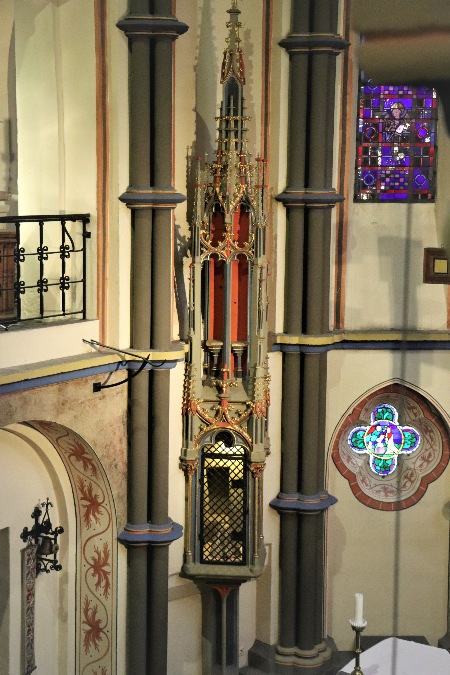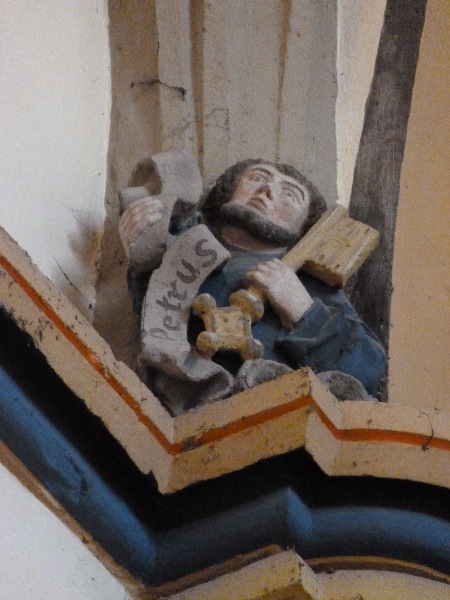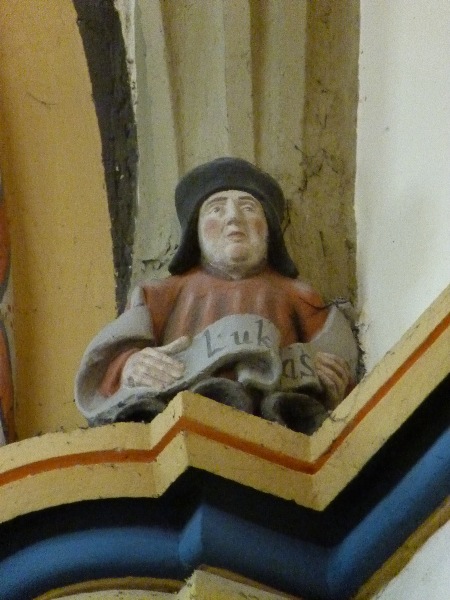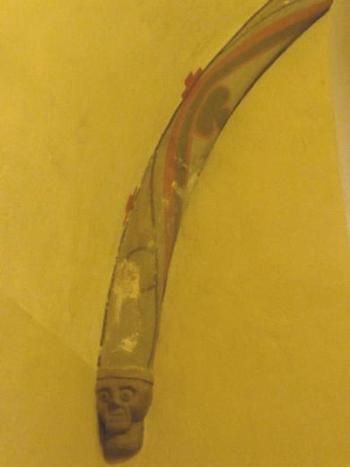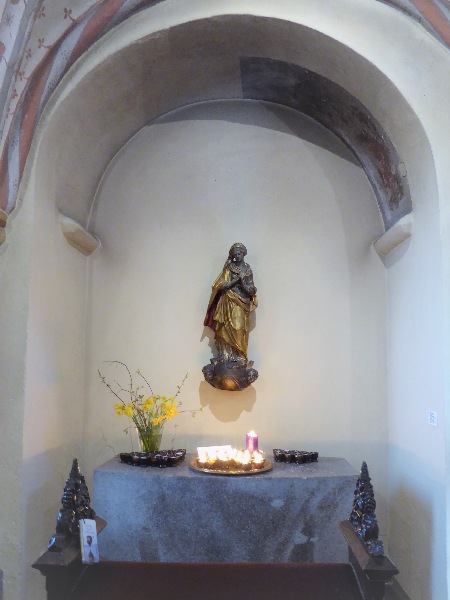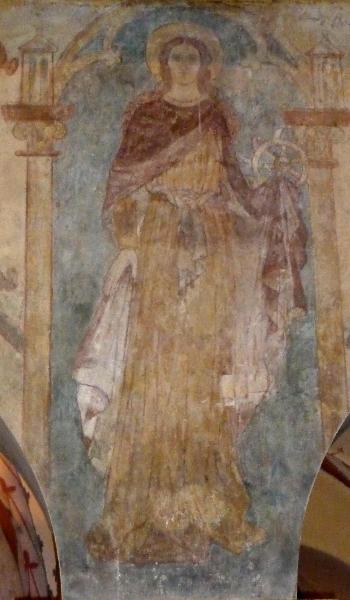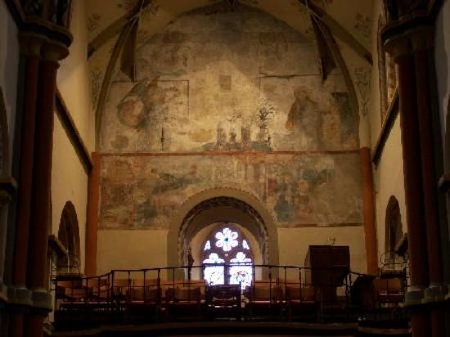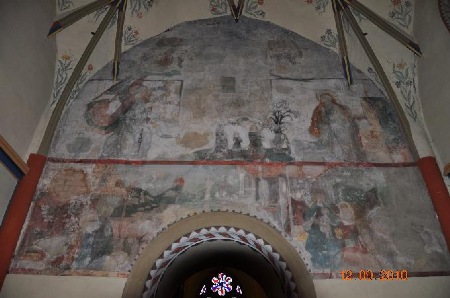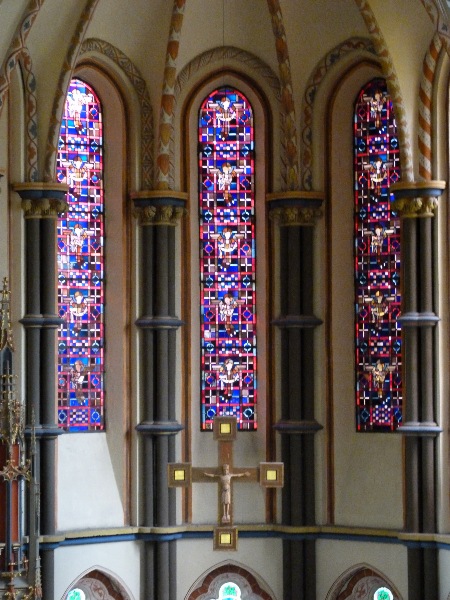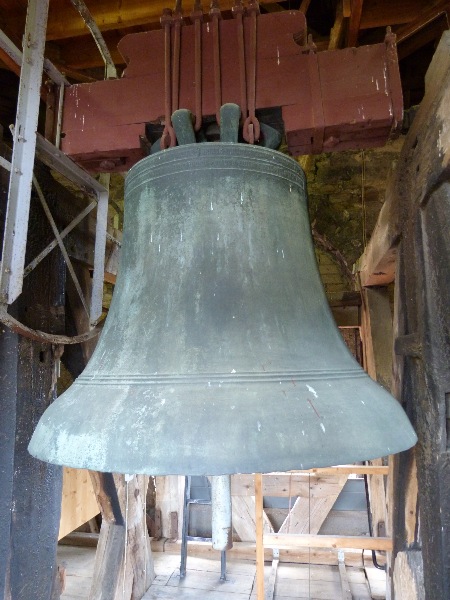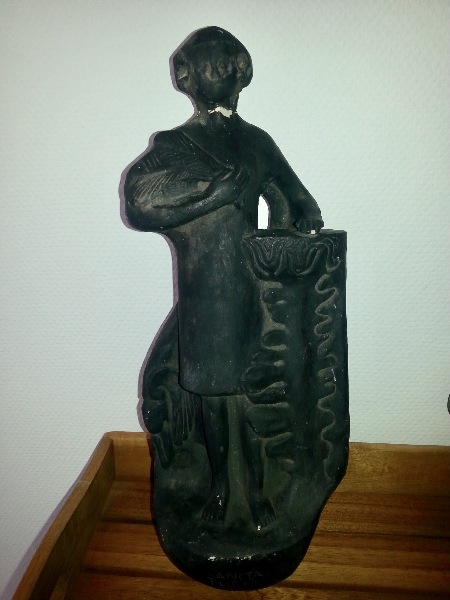


 |
 |
 |



ST. MARTIN - OUR HOME CHURCH
Foto: Anic Cad Studio

![]()
This link provides you with lots of information about St. Martin
Foto: Herwi Rechmann

- Beschreibung, Lage, Grundriss, chronologischer Überblick der Martinskirche
- Kirchenschätze und Wandmalereien
- architektonische Vielfalt der Fenster
- beide Emporen und den Glockenturm
- Kirchenschätze aus der Bibliotheke und das älteste Parament
- Marienaltar (1463) und Gnadenstuhl (1461)
- Kirchenschätze aus der ehemaligen Linzhausener Kapelle
- Nachlass des Linzer Bildhaueres Günther Oellers
- Nachlass Herwi Rechmann

A SURVIEW OF THE CHUTCH TRASURES IN ST. MARTIN LINZ
- Description, plan and chronological surview of the history
of St. Martin
- Church treasures and wallpaintings
- Architectural variety of the church windows
- Both galleries and the bell tower
- treasures from the
church library and the oldest priest`s
garment
- St. Mary`s Altar and “Gnadenstuhl“ (Trinity)
- Church treasures from
the former Linzhausen Chapel St. Simeon
- The heritage of the Linz sculptor Günther Oellers
- The heritage of Herwi Rechmann
NUN LADEN WIR SIE HERZLICH EIN ZU
"EINEM MOMENT DER STILLE - IN GESCHENKTER ZEIT"
Entweder online oder mit einem ganz persönlichen Besuch!
![]()
We are cordially invite you to take some time
for looking at the picture gallery of St. Martin Linz/Rh.
You migth want to combine your visit to my colourful town on the Rhine
with some moments of peace.


alle Fotos J.P. Chayriguet



The steep road up to St. Martin
leads along the “Seven Pains of Mary“….
1. Station - DARSTELLUNG IM TEMPEL

The presentation of Jesus in the Temple
2. Station - DIE FLUCHT NACH ÄGYPTEN

Christ`s flight into Egypt
3. STATION - JESUS LEHRT IM TEMPEL

Jesus
teaches in the Temple
4. STATION - SIMON VON CYRENE HILFT JESUS DAS KREUZ TRAGEN

Simon
of Cyre helps Jesus to carry the cross
5. STATION - DIE KREUZIGUNG

The crucifixion
of Christ
6. STATION - DIE KREUZABNAHME
 The deposition of Christ
The deposition of Christ
7. STATION - DIE GRABLEGUNG

The burial
of Jesus
BIS ZUM HOCHKREUZ IM TILMANN - JOEL - PARK

……up
to the High Cross in Tilmann Joel Park

WENN SIE ÜBER DEN TREPPENAUFGANG
AUS DER STADT GEKOMMEN SIND
Fotos: Patrizia Bay

![]() Your first impresson of St. Martin Church
Your first impresson of St. Martin Church
when advancing up the flight of stairs from the 'Colorful City''
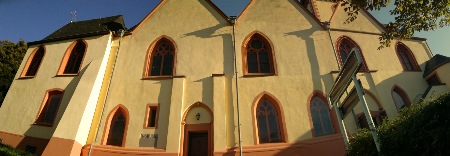
Foto: Dorian Bay


Die Schönheit der Martinskirche, besonders die herausragende Architektur ihres Ostchores und die monumentalen Malereien von 1240/1250 an den Wänden des Mittelschiffs haben schon immer kunstinteressierte Menschen angezogen.
Aber es sind nicht nur die "Fachleute", die den steilen Weg hinauf zur alten Pfarrkirche finden; immer mehr Besucher der Stadt Linz beziehen das exponierte Gotteshaus in ihren Rundgang ein und möchten eingehender über dessen Kirchenschätze informiert werden.

 The beauty of St. Martin Church, especially the outstanding
architecture of its altar choir and the monumental central aisle wallpaintings
from 1240/1250 have always attracted visitors interested in art.
The beauty of St. Martin Church, especially the outstanding
architecture of its altar choir and the monumental central aisle wallpaintings
from 1240/1250 have always attracted visitors interested in art.
But not only the experts
take the steep road up to St. Martin but more and more visitors of the
City of Linz visit the exposed “House of God“ on their tours of the city and
want to be more intensively informed about its church treasres.
Foto: Herwi Rechmann


![]()
Now we would like to report about St. Martin,
with lots of pictures and informations,
do you have some time?
Foto: Herwi Rechmann

Hoch über dem Rhein und der mittelalterlichen Stadt
erhebt sich die dem Hl. Martin geweihte Kirche.
St. Martin steht auf dem höchsten Punkt des Ortskernes am Fuß des Kaiserbergs, und ist damit seit Urzeiten vor dem immer wiederkehrenden Hochwasser des Rheines geschützt.
Auf dieser alten Stadtkarte von Linz sind auf dem Marktplatz im Ortskern auch die Ratskapelle und das Rathaus zu erkennen, sowie die vier Stadttore; unten das Rheintor (Westen), oben das Neutor (Osten), rechts das Leetor (Süden) und links das Grabentor (Norden).
Die Stadtmauer umfasst die ganze Stadt.

![]()
St. Martin Church, Linz is situated at the highest site of the city centre, at the foot of Kaiserberg and thus it has been safe from the repeated floodings of the Rhine since early history.
On this old city map of Linz you can see the City Council Chapel and the Town Hall on the Market Square in the city centre, the four city gates 'Rhine Gate' (west), 'New Gate' (east), 'Lion's Gate' (south) and 'Ditch Gate' (north), the city wall is still encircling the whole town.
Foto: Herwi Rechmann

Der Ursprung der Vorgängerbauten liegt im Dunkeln und könnte bis in die fränkische Zeit zurückreichen.
Die heutige Kirche wird durch spätromanische und gotische Formen bestimmt.
Die dreischiffige Emporenbasilika mit Westturm und polygonalem Chor zeigt eine Reihe von architektonischen Unstimmigkeiten, die durch wechselnde Baupläne zu erklären sind.
Die größten Teile des Westturmes und die untere Zone des Mittelschiffs wurden in den nicht sicher überlieferten Baudaten 1206 - 1214 im romanischen Stil errichtet.
Nach einem Planwechsel entstanden um 1230/1240 die Emporen mit ihren Spitzbögen, die Seitenschiffe, das Turmobergeschoß und der Chor im frühgotischen Stil.
Das Mittelschiff war mit einer heute nicht mehr erhaltenen Holztonne überspannt.
Die meisten Fenster, das Sterngewölbe des Mittelschiffs, die Taufkapelle sowie die Dächer der Kirche wurden 1500 erneuert und repräsentieren die spätgotische Zeit.
Nach 1500 erfuhr die Architektur der St. Martin Kirche nur geringfügige Änderungen; selbst nach dem Zweiten Weltkrieg waren nur geringe Schäden zu reparieren (Fenster).
![]()
High above the River Rhine and the medieval city of Linz St. Martin, the parish church, is situated.
The history of its predecessors remains obscure but could date back into Franconian times (9th century).
The architecture of the present church is dominated by the late-romanic and gothic style.
The church with three aisles, two galleries, a western tower and a polygonal choir apse shows a number of disharmonic elements due to changes in the building plans.
The greater part of the western tower, the lower zone of the central aisle were supposedly erected between 1206 and 1214 in the Romanic style.
After changing the building plans in the time between 1230 and 1240 the upper galleries with their pointed vaults, the side aisles, the upper floors of the tower and the choir apse were build in the early-gothic style.
The central aisle was spanned by a wooden vault witch was replaced at the end of the 15 th/ beginning of the 16 th century.
Most of the windows, the netted vault of the central aisle, the St. Sebastian Chapel as well as the roofs of the church and its Gothic steeple represent the late gothic style.
After the year 1500 the architecture of St. Martin was changed only marginally and even World War II brought only minor damages (e.g.: windows).

Fotos: Herwi Rechmann
![]() PLAN OF ST. MARTIN
PLAN OF ST. MARTIN
Grundriss St. Martin Untergeschoß

Grundriss St. Martin Obergeschoß


LÄNGSSCHNITT
![]() longitudinal section
longitudinal section

QUERSCHNITT
![]() cross section
cross section

![]() CHOIR APSE TO THE EAST
CHOIR APSE TO THE EAST
Das Mittelschiff
mit dem spätgotischem Gewölbe und den beiden Emporen.
Die nördliche Empore benannt als Katharinenempore,
die südliche Empore mit Namen Nikolausempore.
Foto: Dorian Bay
![]()
Central aisle of St. Martin with late gothic vaulted ceiling
and two galleries.
Northern gallery: St. Catherine's Gallery
Southern gallery: St. Nicolas Gallery


![]() HISTORY
HISTORY
Foto: Patrizia Bay
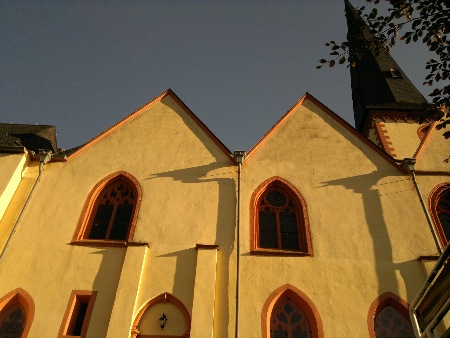
9. Jahrhundert
Bau einer (hölzernen?) Vorgängerkirche durch die Franken.
1198
Zerstörung dieser Kirche im Thronstreit zwischen Otto IV und Philipp von Schwaben.
1206
Grundsteinlegung durch Erzbischof Johann von Trier.
1214
24.08. am Bartholomäustag findet die Weihe von St. Martin nach nicht ganz gesicherten Quellen statt.
Ganz sicher aber wurde St. Martin im ersten Drittel des 13. Jh. erbaut.
1217
wurde die Kirche dem Stift Gerresheim (heute südlicher Stadtteil von Düsseldorf) inkorporiert. Das Damenstift ist wohl auch als Bauherr anzusehen (Ähnlichkeit von St. Martin Linz und St. Margarethe Gerresheim)
Für die frühe Bauentwicklung sind zwei Baumeister erkennbar:
1. Baumeister - spätromanisch - Westturm, spätromanische Arkaden, Chorjochtürme im Osten des Langhauses.
2. Baumeister - frühgotisch-spitzbogige Emporenarkaden, Errichtung des hohen Chores, Verzicht auf Chorjochtürme.
1230
spätromanische Wandmalereien im Mittelschiff. Diese wurden in der Barockzeit übermalt, 1861 wieder aufgedeckt und 1992 gesichert.
um 1500
der spätgotische Umbau - Sterngewölbe, Erweiterungen der Seitenschiffe, Veränderung der Fenster, spitzer Turmhelm.
![]()
9th century
A Franconian church from the end of the 9th century was destroyed in 1198 during fights between Otto IV and Phillip von Schwaben.
1206
Foundation of St. Martin Linz by Archbisop Johann von Trier
1214
on August 24th on St. Bartholemew St. Martin Linz is consecrated according to local tradition. St. Martin, however, was definitely built in the first third of the 13th century.
1217
St. Martin Linz was incorporated in the Ladies' Abbey of Gerresheim who also must be regarded as the financiers of the erection of the church in the preceding years.
In the early construction period the influences of two constructors are visible.
Constructor I - late-romanic: western tower, late Romanic galleries, choir apse towers.
Constructor II - early-gothic: pointed vaults, choir apse windows.
1230
late-romanic wall paintings in the central aisle which had been overpainted in baroque times, were rediscovered in 1861 and secured in 1992.
abbout 1500
late-gothic reconstruction: netted vault in central aisle, enlargement of the side aisles, pointed late-gothic windows in the upper galleries, pointed steeple.



![]()
PLEASE FOLLOW US THROUGH
THE WIDE - OPEN GATES
Foto: J.P. Chayriguet


![]() Altar and Tabernacle
Altar and Tabernacle
Foto: Dorian Bay
Der heute im Chor stehende Altar,
eine Arbeit des Bildhauers Günther Oellers, entstand 1965.
(Der Künstler verstarb im Mai 2011).
Der Altar ist aus Basaltlava gestaltet und umkleidet
den historischen Stipes mit dem Sepulcrum (1214).
Die Mensa trägt die Inschrift:
MORIENS DOMINUS
In der niedrigen Sockelzone des Chors befinden sich
vier Vierpassfenster.
Blendbogen und Fenstergewände sind durch
ockerfarbene Blattranken gestaltet.
![]()
Altar and Tabernacle
The present altar, a work by G. Oellers - Linz,
was erected in 1955.
It is made of basalt and includes the historial altar core from 1214.
The inscription in the mensa says: MORIENS DOMINUS
Four clover - leaf windwos in the lower part of the choir apse wall.
Clover - leaf windows decorated with orange leaves.
Foto: Diana Adams
VIERPASSFENSTER
Die Verglasung der Vierpassfenster in den Farben
Rot, Blau, Grün und Gelb
zeigt Motive der Opferung aus dem Alten Testament.
![]()
The stained glass of the clover leaf windows
in red, blue, green and yellow
shows the sacrifice of Isaac from the Old Testament.
SPÄTGOTISCHES SAKRAMENTSHAUS
16. Jahrhundert
![]() LATE GOTHIC TABERNACLE
LATE GOTHIC TABERNACLE
( 16th cent.)
Foto: J.P. Chayriguet


![]() TABERNACLE
TABERNACLE

über dem Hauptaltar
Ars Liturgica Maria Laach 1950
ursprünglich Kapuzinerkirche Linz (heute Stadthalle).
Foto: Diana Adams
![]() TRIUMPHAL CRUCIFIX
TRIUMPHAL CRUCIFIX
from Maria Laach Monastery
originally in Church of the Capuchins (today Municipal Hall)
BLICK AUF DIE RÜCKSEITE DES ALTARKREUZES
Die fünf Edelsteine erinnern
an die verklärten Wundmale des Herrn.
Bitte nehmen Sie auf dem nächsten Foto
den Mittelpunkt des Kreuzes in Augenschein ....
![]()
TRIUMPHAL CRUCIFIX: backside
Here you can see five precious stones, symbolizing
the stigmata of our Lord Jesus Christ.
Please have a lock at the middle of the crucifix ...
and admire these valuables.
Foto: Damian Bay

.... und bewundern Sie diese sonst nicht einsehbare Kostbarkeit.


![]() High up in the central aisle...
High up in the central aisle...
Fotos: Diana Adams
den HEILIGEN PETRUS
![]()
you will find ...
at close look from the organ gallery ...
ST. PETER
den HL. JOHANNES ST.JOHN
.... den HEILIGEN ANDREAS ST. ANDREW
und den HEILIGEN LUKAS ST. LUKE





![]() CAPITAL
CAPITAL
Fotos: Dorian Bay
An der echten Seite des Einganges ... Konsolkapitel mit Köpfen
![]()
to the right of the side entrance: masks at the end of a capital
DER KIRCHENNARR (Ausgang links)
Fotos: Diana Adams
![]()
our church jester


![]()
late gothic vaulted ceiling
Fotos: J.P. Chayriguet


Fotos: Manfred Niderée

![]() parts of the vaulted ceiling
parts of the vaulted ceiling
... sehen Sie das Gesicht ? (Chorraum)
Fotos: Diana Adams

![]() ... can you see the face ?
... can you see the face ?

Von der Nikolausempore -
im Gewölbe über der Orgelempore -
kann man dieses Gesicht sehen !
![]() ... UNBELIEVABLE ...
... UNBELIEVABLE ...
![]()
Incredible things can be seen from
St. Nicholas Gallery in the vaulted ceiling of the main aisle.
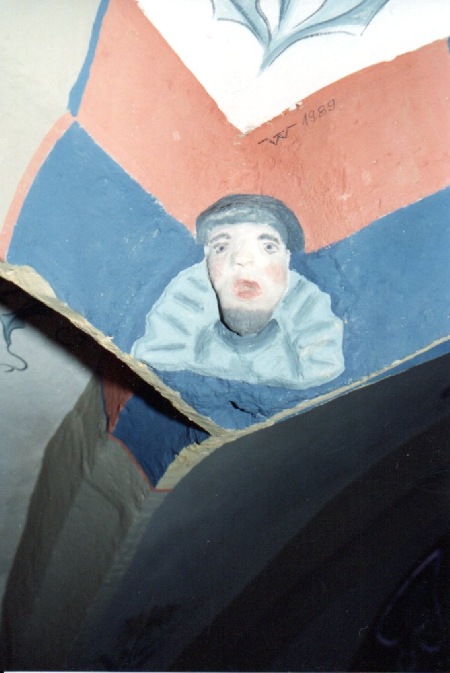

![]() KEY STONES
KEY STONES
SCHLUSSSTEIN HL. MARTIN (Turmhalle)
Fotos: Diana Adams
![]() key stone ST. MARTIN
key stone ST. MARTIN


![]()
SEBASTIANUS CHAPEL
SCHLUSSSTEIN HL. SEBASTIAN
![]() key stone ST. SEBASTIAN
key stone ST. SEBASTIAN
Fotos: Josef Birrenbach

![]()
Late Gothic vaulted ceiling St. Sebastianus Chapel
Key stone St. Sebastianus
Donor's coat-of-arms

Im Netzgewölbe das Stifterwappen Hermann IV. von Hessen
und Schlussstein HL. Sebastian
![]()
Donor's coat-of-arms.
Cologne Archbishop and Prince Elector Hermann IV from Hessia
(1450 - 1508 archbishop 1480 - 1508 )
influenced the history of Linz
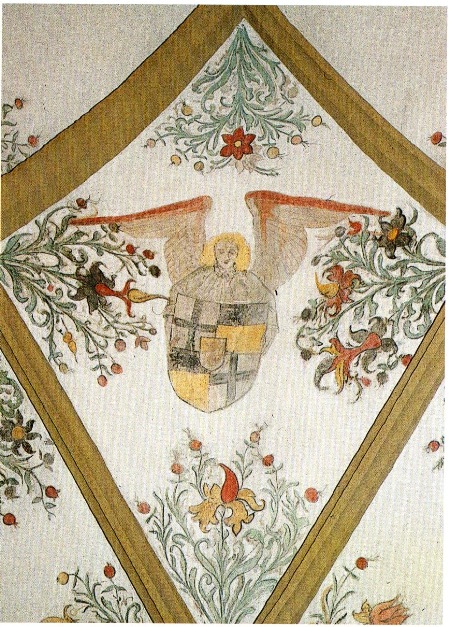
STIFTERWAPPEN
des Kölner Erzbishofs und Kurfürstern
Hermann IV. von Hessen
(1449/50-1508 Regierungszeit 1480 - 1508).
Die Politik des Kurfürsten war mit der
Stadt Linz maßgeblich verknüpft.
TAUFSTEIN


frühes 16.Jahrhundert in der St. Sebastianuskapelle
![]() BAPTISMAL FONT in St. Sebastianus Chapel
BAPTISMAL FONT in St. Sebastianus Chapel
16th century




cast iron plate 1666

GRABPLATTE der Eheleute
Laurenz Cloes und Maria Muler
Laurenz Cloes baute nach dem 30jährigen Krieg
die Eisenhütten in Borscheid bei Neustadt/Wied und Horhausen wieder auf.
Sein Name findet sich im Taufregister 1655
anlässlich der Geburt seines Sohnes.
Seine Frau Maria Muler ist urkundlich 1656 fassbar.
Laurenz Cloes erwarb ein Haus in Linz, heute Neustraße 5.
Das Epitaph trägt im oberen Drittel die Hauswappen,
im unteren Teil Zeichen der Vergänglichkeit:
Totenschädel mit gekreuzten Gebeinen,
Pfeil, Sense, Schlange, Kröte und Sanduhr.
![]()
After the 30 Years' War (1618 - 1648) Laurenz Cloes re-erected
the ironworks in Borscheid near Neustadt/Wied and Horhausen.
His name can be found in the baptismal book in 1655 when his son was baptised.
His wife Maria Muler is mentioned in the records of 1656.
Laurenz Cloes purchased a house in Linz, today 'Neustraße 5'.
The epitaph shows his personal coat-of-arms in its upper part.
In the lower part symbols of transitoriness like:
a skull with crossed bones
an arrow, a scythe, a serpent, a toad and a sandglass
are displayed.

INSCHRIFT DES EPITAPH
HIR BERAWN DER GESLECHT/
VON DEM ERSAME LAVRENS CLOES/
VND MARIA MULER EHLEVD/
GODT GENADEN DEREN SEHLEN
"Hier ruht das Geschlecht
von dem ehrsamen Laurenz Cloes
und Maria Muler, Eheleute,
Gott sei deren Seelen gnädig"
![]()
inscription
Here lies buried the family of the honorable Laurenz Cloes
and Maria Muler, spouses. God grant their souls mercy.

HEVD MIR MORGEN DIR/
WAS DV BIST BIN ICH GEWESEN/
WAS ICH BIN MVS DV WERDEN
"Heute mir morgen dir,
was du bist bin ich gewesen,
was ich bin musst du werden"
![]()
Today me, tomorrow you
what you are now I was so once
what I am now you still will have to become

von 1612
Chorstuhl der Familie Freiling mit Familienwappen
Johannes Freiling (Freyling) war in der Linzer Stadtgeschichte eine angesehene Persönlichkeit.
1575 erwarb er das Haus Am Gestade 4, wurde 1578 Schützenkönig der Sebastianer-Schützenbruderschaft, bekleidete das Amt des Zollschreibers, und war in den Jahren 1602/03 Bürgermeister der Stadt Linz.
Die wohlhabende Familie war ein großer Wohltäter für die St. Martin Kirche, und stiftete z.B. 1582 einen neuen Einband für das LINZER MISSALE.
![]()
Pew 1612
Pew of Family Freiling with coat-of-arms
Johann Freiling was a well-respected citizen of Linz. In 1575 he purchased the house 'Am Gestade 4'', became King of the local rifle club in 1578, was a customs official and in the years 1602/03 he was Mayor of Linz.
In well-off family Freiling was a great donor of St. Martin Church, donating besides this pew a new cover of the Linzer Missale manuscript in 1582.

Die Sandsteinskulptur des Hl. Martin (1512) stand
ursprünglich über dem Hauptportal des Westturmes.
Dort befindet sich heute eine Replik.
St. Martin wird in der Szene der Mantelteilung dargestellt.
Heute befindet sich die Skulptur im Chorraum
unter der Wandmalerei des H. Martin.
Foto: Diana Adams

Foto: Manfred Niderée
![]()
Central nave, choir apse
sandstone sculpture of St. Martin (1512)
This sandstone sculpture, dated 1512, had originally been placed above the main gate.
For conservation reasons the St. Martin Sculpture was positioned in the choir apse (southern wall) in 1988 and outside above the main gate the original sculpture was replaced by a replica.
St. Martin is shown as a small, rather stout soldier, horse and rider are turned towards the spectator. Bridle and hoofs as well as the saint's sword are golden.
St. Martin is just sharing his coat with the beggar. The beggar, with a naked breast and his amputated legs is leaning on a crutch.
Remarkable items in this sculpture are the broken stem and the big blossom.
Foto: J.P. Chayriguet
Nachbildung des Hl. Martin über dem Hauptportal -
Bildhauer Jakob Schmitz aus Kruft 1978



Fotos: JP Chayriguet
![]()
St. Mary's Altar in St. Martin
Northern side aisle

MARIA IMMACULATA
Maria von der Unbefleckten Empfängnis
letztes Viertel der 17. Jh.
![]()
Maria Immaculata
last quarter of the 17th century




![]() WALL PAINTINGS 1240 - 1250
WALL PAINTINGS 1240 - 1250

![]()
wall painting - central nave - southern wall

die monumentalen Darstellungen männlicher und weiblicher Heiligen.
Foto: Damian Bay
Im südlichen Seitenschiff - unter der Nikolausempore -
finden Sie die Darstellungen der männlichen Heiligen.
Hl. Jakobus der Ältere - Pilgerkrönung - Santiago de Compostela
Hl. Petrus
Hl. Martin
![]()
In the central nave the monumental wall paintings from 1240 - 1250 can be found,
the southern wall showing mail saints
St. Jacob the Elder, St. Peter, St. Martin.


Foto - CREATIV PICTURE www.creativ-picture.de

JAKOBUS DER ÄLTERE ST. JACOB THE ELDER
JAKOBUS DER ÄLTERE PILGERKRÖNUNG
(Darstellung der Wallfahrt nach Santiago de Compostela)
Der Hl. Jakobus ist erkennbar an der Muschel, die seinen Mantel schließt.
Als Einziger der dargestellten Heiligen greift der Apostel mit seinen Armen über die Rahmenarchitektur hinaus und setzt zwei knienden Pilgern Kronen auf.
Auch wird der Apostel nicht von Engeln zu seiner Rechten und Linken begleitet, sondern auf Wegarkaden strömen Pilger zu ihm hin.
Die Zeit um 1250, als diese Wandmalerei entstand, war die Hochblüte der Wallfahrt nach Santiago.
In Taufregistern der Pfarrei von 1745/1764 sind in der Martinskirche Kinder getauft worden, deren Eltern sich auf einer solchen Wallfahrt befanden. Linz ist somit über Jahrhunderte als "Zwischenstation" der Wallfahrer zu werten.
![]()
wall painting central nave
St. Jacob, the Elder
Coronation of the Pilgrims
(illustration of the Pilgrimage to Santiago de Compostela, Spain)
St. Jacob can be recognized by the shell closing his coat.
He is the only one of the depicted saints stretching his arms to the right and to the left and crowning two kneeling pilgrims.
This disciple is not acompanied by two angels to his right and left but pilgrims are advancing towards him on winding ways.
The time between 1240 and 1250, the period when the wall paintings were made, is the prime time of the pilgrimage to Santiago de Compostela.
Still on the baptismal register of Linz from 1745/1764 declare the parents of babies to be baptised declare to be pilgrims on their way to Santiago. So Linz can be regarded a stop over the pilgrimage to Spain for many centuries.
Foto: CREATIV PICTURE www.creativ-picture.de


Fotos: Damian Bay



Foto: CREATIV PICTURE www.creativ-picture.de

HL. PETRUS
Im Mitteljoch ist der Hl. Petrus als Schutzpatron
der Bistümer Trier und Köln abgebildet.
In der rechten Hand hält er den Schlüssel, in der linken den Kreuzstab.
Er wird beidseitig von Engeln mit Weihrauchfass und Kerzen begleitet.
![]()
ST. PETER
In the centre of the southern wall St. Peter,
patron saint of the dioceses of Trier and Cologne, is painted.
In his right hand he has the key, in his left the crosier,
on both his sides flying angels with incense burners and candles.
HL. PETRUS ST. PETER

Fotos: Damian Bay



Foto: CREATIV PICTURE www.creativ-picture.de
HL. MARTIN
ALS SKULPTUR UND WANDGEMÄLDE
Das Ostjoch zeigt den Hl. Martin - Schutzpatron unserer Pfarrgemeinde.
Er trägt eine niedrige Mitra sowie seinen Krumstab.
Mit der linken Hand breitet er seinen Mantel schützend
über der Kirche und der Stadt aus.
Zu beiden Seiten des Heiligen knien Assistenzengel
mit Kerze und Weihrauchfass.
![]()
OUR PATRON SAINT
ST. MARTIN
wall painting and sculpture, southern choir wall
Next to the choir apse St. Martin is shown
- the patron saint of our parish church -
wearing a mitre and spreading his coat over the church and the City of Linz.
On both his sides angels with incense burners and candles can be seen.
HL. MARTIN ST. MARTIN

Fotos: Damian Bay


Beispiel einer freien Übermalung von 1860
mit Merkmalen der spätgotischen Veränderung, steiler Turmhelm
zugespitzte Fensteröffnungen, längs- und quergestellte Satteldächer, Anbauten.
Eingefügt die ganze Stadt Linz unter dem Schutz von St. Martin.



![]()
wall paintings - central nave northern wall
Auf der Nordwand des Mittelschiffs
- unter der Katharinenempore -
befinden sich die Darstellungen der weiblichen Heiligen.
Hl. Ursula
Hl. Margaretha
Hl. Katharina und die Hl. Barbara.
Margaretha, Katharina und Barbara
sind die einzigsten weiblichen Heiligen
unter den 14 Nothelfern.
![]()
On the northern wall of the central nave
- under St. Catherine's Gallery -
the wall paintings of the female saints are shown.
St. Ursula, St. Margareth, St. Catherine, St. Barbara.
St. Margareth, St. Catherin and St. Barbara
are the only females among the 14 Auxiliary Saints.

Foto: CREATIV PICTURE https://creativ-picture.de/
HL. URSULA
Auf dieser Seite des Mittelschiffs - im Westjoch
befindet sich die Hl. Ursula,
die in der rechten Hand die Krone des Lebens hält.
Ihre linke Hand weist auf ihre Gefährtinnen, denen sich ein Engel zuwendet.
Rechts von der Heiligen steht wiederum ein Engel,
hinter dem ein weiterer Engel und eine kleine Person angeordnet sind.
![]()
ST. URSULA and her companions
In the western part of the central nave's northern wall
St. Ursula is shown holding a crown in her hand.
Her left hand is pointing at her female companions
being approached by an angel.
To the right of the saint another angel and a small person can be seen.
HL. URSULA ST. URSULA

Fotos: Damian Bay
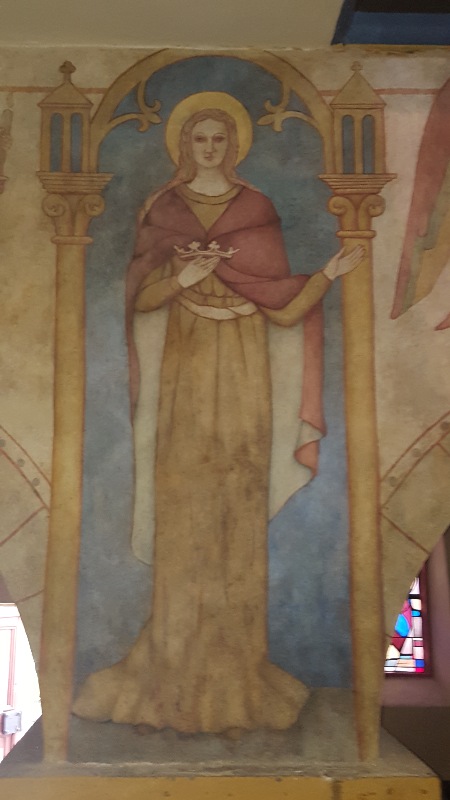

Foto: Manfred Niderée Darstellung der Jungfrauen

Foto: CREATIV PICTURE https://creativ-picture.de/
HL. MARAGETHA
Im Mitteljoch wurde die Hl. Margaretha abgebildet.
Sie trägt eine Krone auf ihrem Haupt,
und hält mit der linken Hand den Drachen an der Kette.
Rechts und links neben ihr knien Engel mit Kerze und Kreuz.
![]()
ST. MARGARETH with angels - right and left
In the middle part of the northern wall we see the painting
of St. Margareth wearing a crown on her head
and holding a chained little dragon with her left hand,
two angels with candles and crucifixes accompany her.
HL. MARGARETHA ST. MARGARETH

Foto: Damian Bay



Foto: CREATIV PICTURE https://creativ-picture.de/
HL. KATHARINA v. ALEXANDRIA (links)
HL. BARBARA (rechts)
Das längere Ostjoch zeigt
die Hl. Katharina mit dem Rad als Hinweis auf ihr Martyrium
und die Hl. Barbara mit dem Turm.
Zur Rechten beider Heiligen ein kniender Engel
mit hoch geschwungenem Weihrauchfass.
![]()
ST. CATHERINE from ALEXANDRIA (on the left)
ST. BARBARA (on the right)
The prolonged eastern part of the northern wall shows
St. Catherine with the wheel as the instrument of her martyrdom
and St. Barbara
to their right a kneeling angel with an incense burner.
HL. KATHARINA ST. CATHERINE

Fotos: Damian Bay
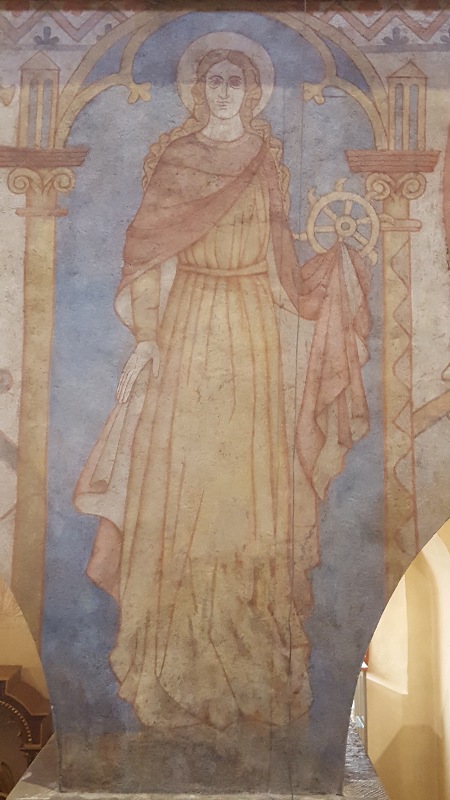


Foto: CREATIV PICTURE https://creativ-picture.de/
HL. BARBARA ST. BARBARA

Fotos: Damian Bay






MARIA MIT JESUS UND PILGER
Nördliches Seitenschiff
nach der Restaurierung im März 2016

VISIBLE AGAIN
Mary
with Jesus and pilgrim
Northern
side aisle
after
the restoration in March 2016
Foto: Damian Bay




restored wall paintings
St. Catherine`s gallery (northern gallery)
St. Erasmus` martyrdom
Foto: Manfred Niderée


Samson
destroys the Temple
and newly discovered wallpaintings
Foto: Damian Bay

mit zusätzlich freigelegter Wandmalerei




wallpaintings on St. Nicholas`gallery
a scene from the life of St. Nicholas
Foto: J.P. Chayriguet


![]()
WALL PAINTING ABOVE THE ORGAN GALLERY
Fotos: Herwi Rechmann
WANDMALEREI
Westwand
ORGELEMPORE
DARSTELLUNG DER WEIHNACHTSGESCHICHTE
nach Mathäus und Lukas
![]()
wall painting western wall - organ gallery
illustration of the Christmas Gospel according to St. Matthew and St. Luke
Foto: Herwi Rechmann
Das Wandbild zeigt Szenen aus dem Marienleben:
oberes Drittel: keine Darstellung mehr erkennbar
in der Mitte: Mariä Verkündigung
links: Verkündigungsengel
rechts: Maria am Schreibpult
unten - links vom Arkadenbogen: Die Botschaft an die Hirten auf dem Feld
unten - rechts vom Arkadenbogen: Die Anbetung durch die Hl. Drei Könige
![]()
The wall painting shows scenes from the life of the Virgin Mary.
upper part: no more pictures visible
centre: The Annunciatioin
to the left: the angel to the right: Virgin Mary
lower part - to the left of the archway: The gospel to the shephards on the fields
lower part - to the right of the archway: The adoration of the 3 Magi
darunter - Stiftergruppe
![]()
possibly the donors

Fotos: J.P. Chayriguet



SANKT MARTIN
verdankt den überregionalen Bekanntheitsgrad
nicht zuletzt diesem monumentalen Bilderzyklus!
![]()
Our St. Martin Church
is known far beyond the Rhine Valley for its monumental wall paintings.
Foto: Dorian Bay


![]()
Architectural variety of the windows
Fotos: Herwi Rechmann
WESTFENSTER im ersten Turmgeschoss
Die Verglasung zeigt das Zunftbild
der Lohgerber und der Metzger im Wappen
(Zunftzeichen rechts und links im Wappen)
unter der gekrönten barocken Madonna,
die der Blickfang des Fensters ist, ebenso wie die Jahreszahl 1734.
![]()
Western window on the steeple gallery
The glass shows the guild logos of the tanners and the butchers
(the guild symbols to the right and to the left of the coat of arms)
and the date 1734 underneath the crowned baroque Madonna.

Foto: Diana Adams
![]()
Above the big western gate
St. Michael's window



window
with scenes from the life of St. Martin
Foto: Diana Adams
SEBASTIANUSKAPELLE
FENSTER MIT SZENEN AUS DER LEIDENSGESCHICHTE
DES HL. SEBASTIANUS
Foto: Herwi Rechmann

![]()
St. Sebastian's Chapel
window with scenes from the passion of St. Sebastian
CHORRAUM
DIE SCHLANKEN LANZETTFENSTER IM CHORRAUM
(1954/1955 erneuert)
leuchten in den Farben ROT - BLAU - VIOLETT,
mit Engeln, die eine Harfe oder
ein Schriftband in den Händen halten.
Foto: Diana Adams
![]()
Choir Apse
the slender Choir Apse windows
(renewed in 1954/55)
in red - blue - purple
with angels holding a harp or a sign in their hands.


![]()
Galleries above the side aisles
Foto: Dorian Bay
Katharinenaltar mit dem noch originalen Fußboden aus der Zeit um 1490

KATHARINEN-EMPORE
Auf
der Nordseite das sogenannte Mannhaus
mit dem erhöhten Katharinenchor
über der Sakristei.
Zisterzienserinnen
des ehemaligen Klosters St. Katharinen,
bei Linz gaben diesen Namen.
Die
Ordensschwestern hatten hier ihr Sitzrecht mit Blick auf den Altar.
Der
Fußboden hat noch einen originalen Belag aus der spätgotischen Zeit;
aus
der gleichen Zeit ist die Altarmensa.
![]()
Northern side aisle gallery
St. Catherine's Gallery
On the northern side of the church St. Catherine's Gallery
with its St. Catherine's apse above the sacristy.
The gallery's name goes back to the Cistercian nuns from the former
St. Catherine's Abbey near Linz.
The nuns had seats with a direct view on the altar.
The floor still has its late gothic tiles,
even the altar mensa dates back to these times.

NIKOLAUS-EMPORE
Der
Nikolauschor befindet sich auf der Empore im südlichen Seitenschiff,
und erhielt seinen Namen von einer Darstellung des Hl. Nikolaus
in
Wandmalerei an der Ostwand.
Das spätgotische Maßwerkfenster über dem Altarstein -
mit der Figur des Hl. Nikolaus (Mitte 15. Jhd.) - ist zugesetzt.
Foto: J.P. Chayriguet

![]()
Southern side aisle gallery
St. Nicholas Gallery
St. Nicholas Gallery is situated above the southern side aisle
and its name refers to the wall painting on the eastern wall
showing scenes from the life of St. Nicholas.
St. Nicholas - mid 15th century
formerly from St. Simeon Chapel, Linzhausen
Foto: Diana Adams
HL. NIKOLAUS MITTE 15. JH.
EHEMALS LINZHAUSENER KAPELLE ST. SIMEON
Der Hl. Nikolaus war traditionsgemäß der Patron der Schiffer
und wurde dementsprechend in der Linzhausener "Schifferkapelle" verehrt.
Die Linzer Schifferzunft weist 13 Gründungsmitglieder
in ihrem Zunftbuch von 1699 auf.
Der hl. Nikolaus wird dort in der Vorrede ausdrücklich als Patron bezeichnet.
Die Zunft hatte in der Martinskirche einen eigenen Altar.
![]()
St. Nicholas is the patron saint of the ship owners
and therefore was adored in Linzhausen ship owners' chapel,
on the banks of the Rhine.
The ship owners' guild notes 13 founding
members in its guild book from 1699.
St. Nicholas is its patron saint
- as mentioned in the introduction -
and the guild had its own altar in St. Martin Church.


Die Möglichkeit der Besichtigung ist nur noch auf unserer Homapage möglich.
Viele Fotos der Glocken finden Sie auch am Ende
des Links "INFO" in den "GLÄNZENDEN AUSSICHTEN" - Gästefotos
![]() Accompany us high up into the steeple to the ...
Accompany us high up into the steeple to the ...
Foto: J.P. Chayriguet


![]() ... church bells
... church bells
Fotos: Diana Adams


ALTES UHRWERK
![]() Old clockwork
Old clockwork




TREASURES IN THE CHURCH ARCHIVES

Buchenholz - Köln - vor 1471

Rennenberg Crucifixion
beech
wood – Cologne – before 1471
Fotos: J.P. Chayriguet
Die Familie Rennenberg war die lokale Adeligenfamilie,
die auch als Stifter bei der Erbauung der Martinskirche beteiligt war.

The Rennenberg family was the local noble family
Also involved as a donor in the erection of St. Martin
Church Linz

STIFTER: Hermann VI von Rennenberg und Amalia von Erbach
am unteren Bildrand mit Kindern und dem Familienwappen.

Donor: Hermann
VI of Rennenberg and Amalia of
Erbach ,
his spouse,
shown below the crucifixion
with children and family crest

![]()
TREASURES OF OUR LIBRARY ANTIPHONARY, about 1400

![]()
ANTIPHONAR FROM 1400

ECKBESCHLÄGE VORDERER EINBAND
![]()
corner clasps on the upper cover

PERGAMENTHANDSCHRIFT über 204 SEITEN
mit braun - schwarzer Tinte geschrieben.
Die Lombarden (Anfangsbuchstaben)
sind in Rot und Blau gehalten.
![]()
Parchment manuscript of 204 pages,
written in an browish - black ink.
The initials are red and blue.
Die Gesänge in spätgotischen Hufnagelnoten.
![]()
The songs in late-gothic musical notation
Das Linzer OFFIZIUMS-ANTIPHONAR
enthält die liturgischen Gesänge des Offiziums, d.h. der Stundengebete
im Verlauf des Kirchenjahres,
hier beginnend mit Weihnachten und endend mit dem Fest des Hl. Martin.
Es beinhaltet sowohl Stundenliturgie des Tages:
LAUDES (Morgenlob bei Sonnenaufgang)
PRIM (1. Stunde, 7 Uhr)
TERZ (3. Stunde, 9 Uhr)
SEXT (6. Stunde, 12 Uhr)
NON (9. Stunde, 15 Uhr)
VESPER (Abendlob bei Sonnenuntergang, 18 Uhr)
KOMPLET (Tagesschluss, 20 Uhr)
als auch die der Nacht mit Invitatoriale - MATUTIN
![]()
The Linz Antiphonary contains the lithurgic songs of the hours,
starting with Christmas songs and ending up with songs
for the St. Martin's Day (Nov,11)
It contains the prayers for the hours:
morning prayer (at sunrise)
1st hour, 7 o' clock a.m.
3rd hour, 9 o' clock a.m.
6th hour, 12 o' clock a.m.
9th hour, 3 o' clock p.m.
evensong at sunset, 6 o' clock p.m.
end of the day, 8 o' clock p.m.
as well as the invitation at night - Matutin
Im Innenspiegel des rückwärtigen Buchdeckels
finden sich neben einem Hauszeichen viele, teilweise mit Jahresangaben versehene Namenseinträge.
Die meisten datieren aus der 2. Hälfte des 17. und aus dem Anfang des 18. Jahrhunderts.
Einige dort auch mehrfach benannten, mitunter auch durchgestrichenen Personen stammen aus wohlbekannten Linzer Familien und waren Mitglieder der in Linz etablierten Bruderschaften; es ist anzunehmen, dass sie als weltliche Chorherren die Offizien sangen.
Weitere Informationen zum Linzer Offiziums-Antiphonar finden Sie im Bildband "800 Jahre Katholische Pfarrkirche St. Martin"
![]()
In the inner side of the back cover many handwritten signatures can be found,
dating back to the second half of the 17th and the beginning of the 18th century.
Some of the names mentioned are names of the famous Linzer families and of members of Linz Brotherhoods, we can assume that they sang the songs as laymen.

Am Patronatstag von St. Martin im November 2009
wurde das restaurierte OFFIZIUMS - ANTIPHONAR der Pfarrgemeinde
nach einer feierlichen Zeremonie
unter Mitwirkung des Chur Cölner Chores vorgestellt werden.
![]()
On Nov. 11, 2009
the restored book could be presented to the public
in a concert of the Chur Cöln Choir.

![]()
THE OLDEST CHASUBLE IN OUR CHURCH TREASURE

![]()
The chasuble of the Rennenberg Family
Die FAMILIE VON RENNENBERG
war mit Linz eng verbunden.
Obwohl im Kölner Domkapitel vertreten,
ließen sich mehrere Familienmitglieder
in St. Martin in Linz bestatten.
Wie bei anderen Stiftungen von Kunstwerken
diente auch die Schenkung von Paramenten
der Memoria der Stifter sowie der ganzen Familie.
Das Anbringen des Familienwappens rief die Stifter
bei den Lebenden ins Gedächtnis und erinnerte
an die Fürbitten um das Seelenheil.
![]()
The Rennenberg Family, a noble family,
was closely linked to Linz.
Although members of the Cologne Cathedral Chapter
several members of this noble family were buried in St. Martin Linz.
As with many donations they were giving to prolong
the donors were remembered by the parishioners.
So fixing the family coat-of-arms remembered the parishioners
of the donors and asked for their prayers.

Die STICKEREI der grünen KASEL
wurde im 15. Jahrhundert gearbeitet.
Es handelt sich eine NADELMALEREI in BUNTER SEIDE,
sowie einer RELIEFSTICKEREI mit METALLFÄDEN.
Die GRUNDGEWEBE sind DAMAST und SEIDE.
Vom ursprünglichen Messgewand
ist heute die spätgotische Stickerei erhalten,
die Ende des 19./ Anfang 20. Jh.
auf eine neugearbeitete Kasel übertragen wurde.
Das grüne Grundgewebe zeigt ein Muster,
das in Anlehnung an die Gewebe des neugotichen Stils entstanden ist.
![]()
The embroidery on the green chasuble originates from the 15th century.
It ist needlework in coloured silk with metal threads.
The basic fabric is damask and silk.
Just this late-gothic embroidery has endured times
and has been fixed on a new chasuble
at the end of the 19th/beginning of the 20th century.
The green basic fabric displays a pattern in neo-gothic style.

Im KASELKREUZ wird die Kreuzigungsszene aufgegriffen.
Die Figurengruppe unter dem Kreuz ist auf
Maria und Johannes den Täufer reduziert.
Seitlich und über dem Kreuz
Wappen mit Hostie und Kelch sowie den Passionswerkzeugen.
![]()
In the embroidered cross the crucifixion is shown,
the group under the cross consists of Mary and John, the Baptist,
above and next to the cross you see
a coat-of-arms with the eucharist
and a chalice as well as the passion tools.

Im unteren Teil befindet sich das
STIFTERWAPPEN der FREIHERREN VON RENNENBERG.
Es sind die HELMZIER und
eine kleine Ecke des ROTEN WAPPENS erhalten.
![]()
In the lower part you see
the coat-of-arms of the sponsors,
the Barons of Rennenberg:
the crest and a part of the red coat-of-arms.

Auf der RÜCKSEITE des Paraments sind als HEILIGE
die HL. HELENA MIT DEM KREUZ und ...
![]()
On the back of the parchment saints are embroidered,
St. Helena with the cross and ....

... der HL. PAULUS MIT SCHWERT UND BUCH
aufgestickt.
Beide Heilige stehen in besonderer Verbindung
zum Bistum Trier, der für Linz zuständigen Diözese.
![]()
... St. Paul with sword and book.
Both saints have a special relationship to the diocese of Trier,
the diocese which Linz belongs to.



in the right aisle


Beide
Kölner Tafelmalereien
wurden von TILMANN JOEL
für
die am 10. Okt. 1462 geweihte Ratskapelle
auf
dem Marktplatz gestiftet.


Gnadenstuhl and St. Mary’s Altar
were
both donnated by Tilmann Joel
for
the Linz City Council Chapel in the marketsquare.


Der
Gnadenstuhl
–
früher auf der oberen Etage
der
Linzer Ratskapelle zu finden –
zeigt
die göttliche Dreifaltigkeit inmitten von
vier
Heiligen und dem knienden Stifter.
Gottvater
hält Jesus,
seinen
toten Sohn, in den Händen,
es
fehlt allerdings eine Darstellung des Hl. Geistes,
um die Dreifaltigkeit zu komplettieren.
Bei
den dargestellten Heiligen dürfte es sich um Tilmann Joels Lieblingsheilige
handeln.
In
der linken Zweiergruppe finden wir
links Johannes den Täufer mit dem Lamm
Gottes,
er ist der Namenspatron seines Neffen
und
Mitstifters Johannes Ruysch,
und
rechts
neben ihm den Hl. Andreas, den
Patron der Kölner Andreaskirche,
wo
Tilmann Joel Kölner Pfründe (= Einnahmen) hatte.
Die rechte
Heiligengruppe zeigt
außen den
Hl.
Florin, Patron der gleichnamigen
Kirche in Koblenz, bei der Tilmann Joel Trierer Pfründe hatte.
Bei
der Figur mit Anker handelt es sich um
Papst
Clemens, einen Schutzpatron der
Reisenden.
Zu
Füssen von Gottvater kniet
-im
verkleinerten Maßstab-
der
Stifter Tilmann Joel neben seinem Stifterwappen.
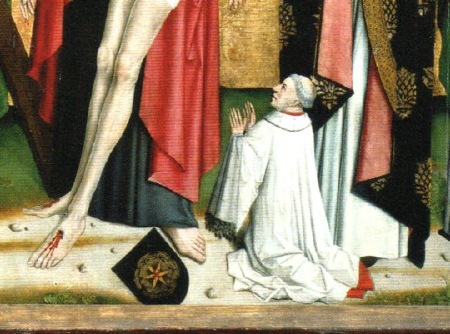
 Gnadenstuhl
painting
–
formerly to be displayed on the upper
gallery
of
the Linz City Council Chapel –
shows
the Holy Trinity in the midst of 4 saints
and
the kneeling donor Tilmann Joel.
Gnadenstuhl
painting
–
formerly to be displayed on the upper
gallery
of
the Linz City Council Chapel –
shows
the Holy Trinity in the midst of 4 saints
and
the kneeling donor Tilmann Joel.
In the centre
Godfather is holding his
dead
son Jesus in his arms,
a
depiction of the Holy Spirit, however, is missing;
thus
the Holy Trinity is incomplete.
It is
assumed that the displayed saints are
Tilmann
Joel‘s favourites.
The left couple shows St. John the
Baptist
with
the Lamb of God, he is the patron saint of
his
nephew and co-donor Johannes Ruysch.
The
saint to the right is St. Andrew, the patron saint
of
St. Andrew`s Church in Cologne, from where
Tilmann
Joel received his Cologne income.
In the right group of saints St. Florin is displayed
on
the extreme right, he is the patron saint of
St.
Florin Church in Koblenz, from where
Tilmann
Joel received his second income,
making
him a wealthy man.
To
the left of St. Florin Pope Clemens with an anchor in his hand, patron
saint of the travellers, is shown.
To
the right of Godfather, in a smaller size,
Tilmann
Joel is kneeling, to his left his
coat of arms.


Fotoquell:Bildband "Spätgotische Altäre in Linz am Rhein" Wilfried Podlech

ST. MARY'S ALTAR 1463

Das ungewöhnliche Bildprogramm des
MARIENALTARES
- von
der Verkündigung über die Geburt und die Auferstehung Jesu
bis zu Pfingsten und
der Marienkrönung –
könnte einem Andachtsbuch
des
Stifters Tilmann Joel entstammen.
Alle
Bilder der Innenseite sind durch den
Goldhintergrund als Festtagsseite
gekennzeichnet,
während die beiden Flügel der Außenseite
Landschaften als
Hintergrund zeigen.
In der
Kreuzigungsszene auf dem Außenflügel kniet
ein Stifter, bei dem es sich um
Johannes Ruysch,
den
Neffen von Tilmann Joel handelt.
Da
Tilmann Joel 1462, 1 Jahr vor Vollendung des Marienaltares, verstarb,
übernahm
wahrscheinlich Johannes Ruysch
die Fertigstellung des Marienaltares und wurde
auf ihm als Stifter dargestellt.
Das Stifterbild seines Onkels Tilmann Joel
findet
sich daher auf dem Gnadenstuhl.


The unusual programme of St. Mary’s Altar
-
from the annunciation via the birth and
the resurrection of Jesus
up to
Pentecost and the coronation of Mary -
could
originate from a prayerbook
of
Tilmann Joel, the donor.
All
the paintings on the interior of the altar
show
a
golden background and are thus called
the
bankholiday side
whereas the two outer wings
show
landscapes in the background.
In
the crucifixion scene on the outer right wing
a donor
is kneeling, Johannes Ruysch,
it isTilmann
Joel’s nephew.
As
Tilmann Joel died in 1462,
one year before
the
completion of St. Mary’s Altar,
probably
Johannes
Ruysch took responsibility
for completing
St.
Mary’s Altar and thus is shown as its donor.
The
donor image of his uncle Tilmann Joel
can be found on Gnadenstuhl.




Some specialties from this St. Mary's Altar
Die geöffnete Feiertagsseite des Altares
zeigt sieben Szenen aus dem Leben Mariens und Christus.
Drei Szenen entfallen auf die Altarflügel
und vier auf die Mitteltafel.
Der Goldhintergrund verbindet alle Szenen miteinander.

The inner boards
shows seven scenes from the lives of St. Mary and Jesus.
Three scenes are displayed on the wings
and four on the central board of the altar.
The scenes are all linked by the golden background.
The donor is displayed on the open and on the closed altarpiece as well.

(geschlossener Altar in der Fasten- und Adventszeit)

THE OUTER WINGS CLOSED



left ANNUNCIATION

Die äußere Verkündigungsszene
zeigt
den Engel Gabriel
kniend vor Maria in einem
palastartigen Raum.
Auf dem Schriftband in
der Hand des Engels stehen die
Begrüßungsworte
„Ave Maria gratia plena…“,
lesbar aus Sicht
Mariens von unten nach oben.
Goldene Strahlen
treffen das Haupt Mariens.
Den Strahlen entlang folgt
das nackte Jesuskind mit geschultertem
Kreuz
und die Taube
des Heiligen Geistes.

The outer annunciation scene
shows the Angel Gabriel kneeling in front of Mary
in a palace-like room.
On the scroll in
the hand of the angel
the angel‘s welcome
is written (in Latin)
“Ave Maria gratia plena …Hail Mary full of grace “,
readable only from
Mary’s position upwards.
Golden rays hit Mary’s head.
On the rays a naked Jesus comes down
with a cross
on his shoulders
following
the dove of the Holy Spirit.


to the right CRUCIFIXION OF JESUS



Die Kreuzigungsszene
zeigt Jesus am
Kreuz mit Maria (links)
und Johannes (rechts).
Drei kleine Engel sammeln
mit goldenen Kelchen
das Blut
aus der Seitenwunde
sowie
der linken und rechten Hand
des Gekreuzigten.
Der Stifter – nach W. Podlech - vermutlich
Johannes Ruysch,
der Neffe Tilmann Joels – kniet vor Maria. Vor ihm sein Stifterwappen.
Sein Gebet wird durch ein
leeres Schriftband angezeigt.
Im Hintergrund erkennt man eine Stadt,
vermutlich das himmlische Jerusalem, möglicherweise auch Linz.

The crucifixion scene
shows
Jesus on the cross
with Mary (on the left)
and St. John (on the right).
Three little angels collect the blood
from Jesus‘ sidewound,
and
from his left and right hand
in golden chalices.
The donor – according to
W. Podlech - probably Johannes Ruysch,
Tilmann Joel’s nephew -
is kneeling in front of Mary.
In front of him his
coat of arms is displayed.
His prayer is indicated
by an empty scroll.
In the background a city is shown,
possibly Jerusalem in heaven,
maybe even Linz.



OPEN ALTARPIECE
to the left THE ANNUNCIATION


Im Gegensatz zu der Darstellung auf
der Altaraußenseite
steht der Engel vor Maria, die betend vor einem roten Himmelbett
sitzt.
Anders als beim Außenflügel erkennt
man in der
linken oberen Ecke
den Ursprung der Strahlen,
Gottvater, der mit ausgebreiteten
Händen
Maria segnet
und ihr kraft seines Wortes
Jesus den Retter sendet.
In ihrem Heiligenschein wird Maria als
Heilige
Maria und
Mutter Christi bezeichnet.

In contrast to the annunciation
on the outer left wing
the angel is standing
in front of Mary
who is sitting
in front of
a red tester bed praying.
In the left upper corner
God the Father is displayed
as the origin of the rays,
blessing Mary with
widespread arms and sending her
Jesus,
the Saviour on
the strength of his word.
In her nimbus Mary is called
Holy Mary and Mother of Christ.


to the right PENTECOST AND THE CORONATION OF MARY

Auf dem rechten Innenflügel
befinden
sich zwei Szenen,
die jedoch als Einheit zu sehen sind.
Unten
das Pfingstereignis mit Maria im Kreis der Apostel
und darüber,
im Wolkenkranz,
die Marienkrönung mit Jesus
als Weltherrscher,
in seiner linken
Hand eine Weltenscheibe.
Die dargestellte Stadt ist vielleicht
die älteste Ansicht der Stadt Linz.




On the right inner wing
two scenes are shown,
which form an integrated whole:
in the lower part Pentecost with Mary
sitting among the disciples
and above it, in a ring of clouds,
the coronation of Mary with
Jesus as Pantocrator,
holding a globe in his left hand.
The city displayed is possibly the
oldest view of the City of Linz.

CHRISTI GEBURT
DIE ANBETUNG DER HL. DREI KÖNIGE
WEISSAGUNG DES SIMEON
MARIA MIT DEM AUFERSTANDENEN CHRISTUS

THE CENTRAL BOARD WITH FOUR SCENES
THE BIRTH OF CHRIST
THE ADORATION OF THE THREE MAGI
THE PROPHECY OF SIMEON
MEETING JESUS, THE RESURRECTED


 THE BIRTH OF CHRIST
THE BIRTH OF CHRIST


 THE ADORATION OF THE THREE MAGI
THE ADORATION OF THE THREE MAGI

Die Anbetung des Kindes durch Maria
und Josef
und die Anbetung der Hl. Drei Könige
finden am gleichen Ort,
einer Palastruine, statt.
Diese soll
den Palast König Salomons darstellen
und somit das Alte mit dem Neuen Testament
verbinden.
Die Anbetung der HL. Drei Könige weist
Ähnlichkeit
mit
Stefan Lochners Dreikönigsdarstellung auf dem
Columba-Altar auf.

The adoration of the child by Mary and
Josef
and the adoration of the three Magi
are set in the same place,
a ruined palace.
This is supposed to
be the Palace of King Solomon
and thus links together the Old and the New Testament.
This adoration scene resembles a lot
the adoration
on the Cologne Altar by Stefan
Lochner, the famous Cologne painter.

 THE PROPHECY OF SIMEON
THE PROPHECY OF SIMEON


In der linken Szene bringt Maria das
Jesuskind
in den Tempel
und trifft dort auf
Simeon.
In der rechten Szene legt Jesus, mit
der Auferstehungsfahne
seine Hand vertrauensvoll auf Mariens
Schoß.
Auch diese beiden Szenen der
Mitteltafel
verbinden
das Alte mit dem Neuen
Testament.
Die Weissagung des Simeon findet vor
einem Altar statt,
dessen Altarbild die Opferung Issaks
durch Abraham darstellt.
Die Begegnung Mariens mit dem auferstandenen
Jesus zeigt beide,
umgeben von Engeln, auf einem Doppelthron,
dessen Armlehnen jeweils
von einem Löwen gekrönt werden;
womit der Thron als
Thron Salomons gekennzeichnet ist.

In the left scene Mary is taking
little Jesus
into the temple
and meets Simeon.
In the right scene Jesus with the resurrection
flag
trustfully puts his hand on Mary’s
lap.
These two scenes link together the Old and the
New Testament, as well.
The prophecy of Simeon takes place in
front of an altar,
the altarpiece of which shows the
sacrifice of Isaak by Abraham.
The meeting of Mary and Jesus shows
them,
surrounded by angels,
on a double
throne,
the arm rests of which are crowned
by two
lions
making it the Throne of King Solomon.

 MEETING JESUS, THE RESURRECTED
MEETING JESUS, THE RESURRECTED





 Church treasures from
Church treasures from
the former Linzhausen Chapel St. Simeon

 Linzhausen Chapel
about 1905
Linzhausen Chapel
about 1905




Linzhausener Madonna - skulpture from 1471




 Ecce homo - Man of Sorrows of the 18 th century
Ecce homo - Man of Sorrows of the 18 th century


"Selbdritt" bedeutet "zu Dritt"
Maria's Mutter Anna - Maria als Kind - und Jesus
 St. Anna, Mother Mary
St. Anna, Mother Mary
and Jesus – sculpture from the last quarter of the 15 th century

Selbdritt - Altar und Schmerzensmann (links) in der Linzhausener Kapelle


 St. Nicholas of the 15 th century
St. Nicholas of the 15 th century

Linzhausener Kapelle St. Simeon - Aufnahme von 1955 mit Umfeld

Fotoquellen: Stadtarchiv Linz - Stadtarchivarin Andrea Rönz
800 Jahre Buch - Denis Steger
Fotos: Diana Adams - Dorian Bay



Günther Oellers, ein Linzer Bildhauer *27. Jan. 1927 in Linz +13. Mai 2011
Der Nachlass des Linzer Künstlers
wurden von den Geschwister Oellers übergeben.










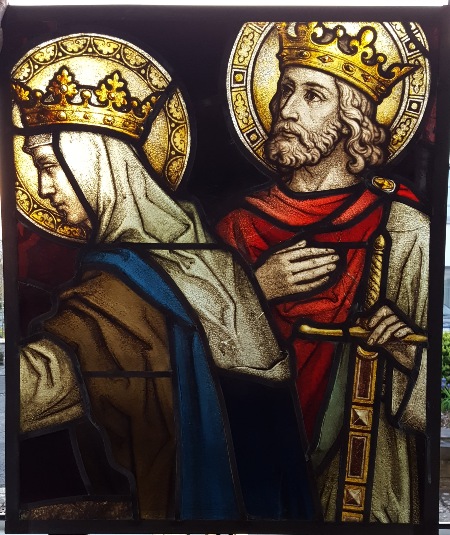





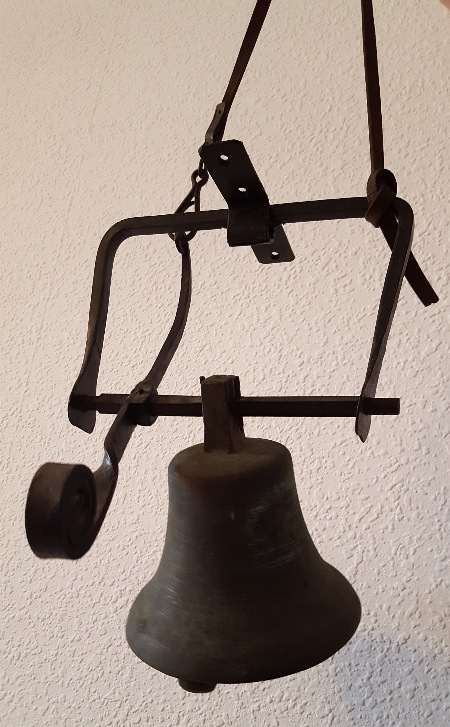







"Königlicher Lustgart" von Valentin Leucht (Köln 1614)

8 Büchern mit Erzählungen von Wundern und Geshichten,
angefangen mit dem "Dialogus Magnus Visionum atque Miraculum"
von Caesarius von Heisterbach.

Ein maßstabgetreues Modell
der Martinskirche in Handarbeit
aus seiner Werkstatt! Danke Herwi!













